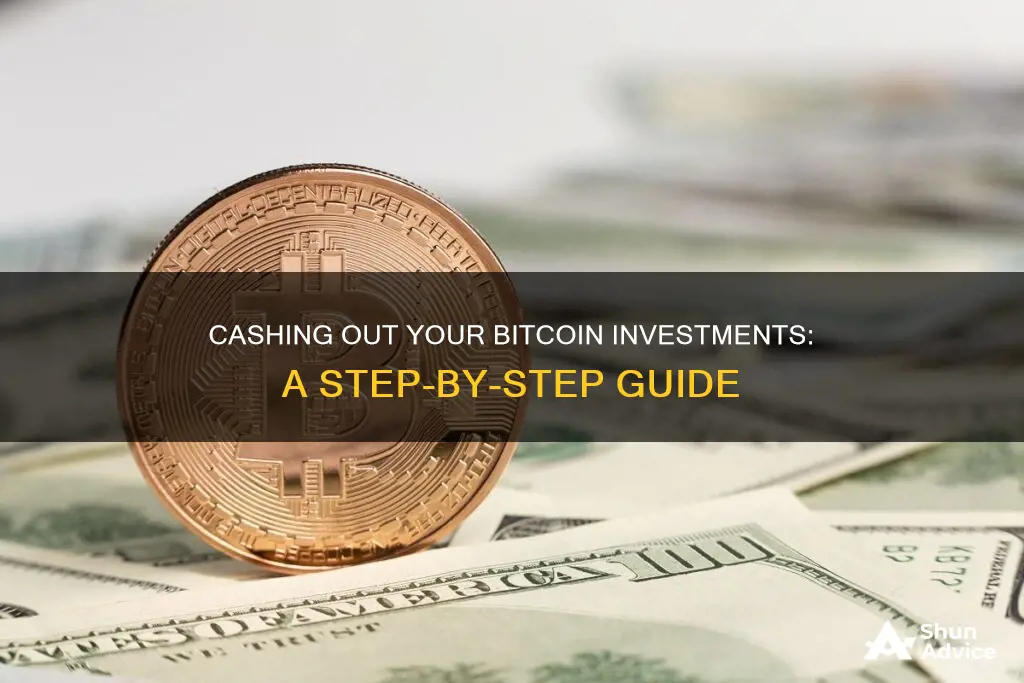
There are several ways to cash out your Bitcoin investments. You can use a crypto exchange, an online broker, a Bitcoin ATM, a crypto debit card, or spend it at a crypto-friendly business.
One of the easiest ways is to use a centralized exchange such as Coinbase, Binance, or Kraken. You can sell your Bitcoin on the exchange for fiat currency and then withdraw the money to your bank account. This typically takes a few days.
Another option is to use a peer-to-peer (P2P) crypto exchange, where you can sell Bitcoin directly to another individual in exchange for cash. P2P exchanges usually have lower fees and allow for more diverse payment methods but may take longer to find a buyer and complete the transaction.
You can also cash out your Bitcoin at a Bitcoin ATM, which provides immediate access to cash. However, these machines often charge high fees, so it's important to consider the cost before using this method.
Before cashing out, it's important to consider the tax implications, as you may owe taxes on any gains made from selling your Bitcoin.
| Characteristics | Values |
|---|---|
| Methods | Centralized crypto exchanges, online brokers, Bitcoin ATMs, crypto debit cards, peer-to-peer crypto trading, money transfer apps, spending at crypto-friendly businesses, bank transfers, cash deposits |
| Time | 1-5 days for money to reach your account |
| Fees | Vary depending on the method, e.g. Coinbase charges $0.99 for selling under $10 worth of crypto, 1.50% for larger transactions, and 0.60% on its "Advanced Trade" platform |
| Anonymity | Peer-to-peer platforms allow for more anonymity |
| Ease | Centralized exchanges are one of the easiest ways to turn Bitcoin into cash |
What You'll Learn

Centralised crypto exchanges
Centralised exchanges are so-called because they use an intermediary or third party to help conduct transactions. Buyers and sellers trust this entity to handle their assets, in the same way, a customer trusts a bank to hold their money. This setup is safer than an individual managing their own assets, as it provides security and monitoring that an individual cannot accomplish alone.
Centralised exchanges directly participate in markets by "clearing" trades. They keep digital order books, which are lists of open buy and sell orders, consisting of volumes and prices. They match up buyers and sellers and announce current market prices based on the last price an asset sells for.
Centralised exchanges are often more secure and easier to use than their decentralised counterparts, but they usually charge higher fees. They are also the most valuable businesses in the crypto world, accounting for around 95% of exchange crypto trading.
Some of the largest centralised cryptocurrency exchanges in the world include:
- Coinbase
- Robinhood
- Kraken
- Gemini
- Binance
- Bittrex
- Bitfinex
- Upbit
- GDAX (an extension of Coinbase)
To cash out your Bitcoin using a centralised exchange, you would deposit your Bitcoin into the exchange, and then request a fiat currency withdrawal. The most common way to do this is via a bank (wire) transfer. You will need to withdraw to the same bank account that you deposited with to avoid breaking money laundering laws.
Using an exchange such as Binance to cash out your Bitcoin normally takes about 1-5 days. For EU customers, payments are made via SEPA (withdrawals paid in Euros). For those wanting to sell Bitcoin for USD, brokers normally use the SWIFT payment method.
MrBeast's Bitcoin Adventure: Did He Invest?
You may want to see also

Crypto debit cards
Here's how they work: you top up your card with the cryptocurrency of your choosing, and then you can use it like a regular debit card. When you make a purchase, your card provider converts your digital currency into fiat currency to use in the transaction.
There are a few things to keep in mind if you're considering a crypto debit card. Firstly, they usually require you to create an account and/or digital wallet with a cryptocurrency exchange. Some also require you to purchase the card or make an investment in the card's native currency to unlock certain benefits. Additionally, there may be fees associated with using the card, such as monthly maintenance fees, foreign transaction fees, and ATM withdrawal fees.
- Coinbase Card: This card can be used anywhere Visa is accepted and supports up to eight different cryptocurrencies. It also has robust security features, including two-factor identification and instant card freeze.
- Wirex Card: The Wirex card supports over 150 traditional and fiat currencies and offers cashback of up to 8% in cryptocurrency. There are no issuance, monthly, or withdrawal fees for this card.
- Crypto.com Visa Card: This card supports over 100 cryptocurrencies and 20 fiat currencies. It offers rebates on streaming services and up to 5% cashback.
- Binance Visa Card: The Binance card has no issuance or monthly fees and charges a low transaction fee of up to 2%. It also offers an impressive 8% cashback, but there is a catch—you need to have a balance of 600 Binance Coins (BNB) to receive the cashback reward.
- BitPay Crypto Debit Card: The BitPay card is a Mastercard debit card that is available in the US only. It supports 15 cryptocurrencies and 8 fiat currencies. There are no annual or monthly fees, but there is a $2.50 ATM withdrawal fee.
- Bybit Crypto Debit Card: This is a Mastercard debit card that is available in the EEA and Australia. It supports eight cryptocurrencies and offers a generous cashback program.
Each of these cards has its own unique features and benefits, so be sure to do your research and choose the one that best suits your needs.
Bitcoin Investment: Is the Crypto Bandwagon Still Accessible?
You may want to see also

Peer-to-peer (P2P) exchanges
A peer-to-peer exchange is an online platform that allows users to interact and transact with each other with minimal oversight. On these platforms, users can freely exchange cryptocurrencies such as Bitcoin for cash or other payment methods. This approach aligns with the decentralised nature of Bitcoin, which was designed as a peer-to-peer payment system.
When using a P2P exchange, you can expect lower fees than on centralised exchanges, and in some cases, no ID verification is required. Additionally, P2P exchanges can offer more privacy than traditional online transactions. However, it is important to note that true peer-to-peer transactions are less common in cryptocurrency due to safety concerns.
One of the most popular P2P platforms is LocalBitcoins, which supports almost every country in the world and allows users to request their preferred payment method. Other well-known P2P platforms include Paxful, Huobi P2P, and Binance P2P.
- Open an account on the P2P platform and set up your profile with a username and a strong password.
- Choose the country where you prefer your buyers to be located. It is recommended to select your own country for convenience and familiarity.
- Specify the amount of Bitcoin you wish to sell and choose your desired payment method.
- Review the available buyers and their offers. Consider factors such as feedback rating, payment method, and price.
- Send a trade request to the buyer you select.
- Once the buyer accepts, send your Bitcoin to the P2P platform's escrow service, which will hold the Bitcoin until the transaction is complete.
- Provide your payment details to the buyer, such as your bank account information or PayPal email address.
- Wait for the buyer to send the payment. Once you have received the payment and confirmed it, release the Bitcoin from the escrow to the buyer.
- If there are any issues or disputes, the P2P platform's customer support or dispute resolution processes can assist in resolving them.
While P2P exchanges offer benefits such as lower fees and increased privacy, there are also some disadvantages to consider. P2P exchanges may have slower transaction speeds compared to centralised exchanges, and the process of finding a suitable buyer and negotiating the sale can be time-consuming. Additionally, there is a higher risk of scams or fraud, so it is important to exercise caution and utilise the platform's security features, such as escrow services.
Nigerians' Guide to Bitcoin Investment
You may want to see also

Bitcoin ATMs
To use a Bitcoin ATM, you will need a Bitcoin wallet. This is a digital tool that allows users to store, send, and receive Bitcoin securely. You can create a Bitcoin wallet by installing an app on your mobile device or laptop/desktop.
Buying Bitcoin from a Bitcoin ATM:
- Enter the amount you want to purchase. Depending on local regulations and the amount you are purchasing, you may be required to verify your identity.
- Provide your Bitcoin wallet address by using the ATM's camera to scan the QR code of your Bitcoin wallet address displayed in your Bitcoin wallet app.
- Pay with cash, credit card, payment app, or debit card.
- Receive the Bitcoin in your Bitcoin wallet. This generally takes a few minutes. The ATM will provide you with a transaction ID to monitor the status of the purchase.
Selling Bitcoin from a Bitcoin ATM:
- Enter the amount you want to sell. Depending on local regulations and the amount you are selling, you may be required to verify your identity.
- Send Bitcoin to the provided address. The ATM will generate a Bitcoin address for your transaction, which you can scan with your Bitcoin wallet app.
- Once the ATM receives the Bitcoin, it will dispense your cash. This generally takes a few minutes, and you can monitor the transaction status using your Bitcoin wallet app.
It is important to note that the commissions on Bitcoin ATM trades can be high, so make sure to check the fees before proceeding with any transactions.
The Ultimate Guide to Investing in Bitcoin Futures
You may want to see also

Gift cards
On Paxful, users can buy and sell Bitcoin with no fees, and the platform is protected with vault-level security. To get started, users must first sign up for a Paxful account and verify their account to get a free Bitcoin wallet with 2FA security. After finding a vendor and reading the requirements, users can start the trade by setting the amount of Bitcoin they want to buy. Once the payment is made, the vendor's Bitcoin is locked in escrow to prevent the trade partner from accepting payment without releasing the crypto.
Prestmit offers similar services, allowing users to sell gift cards for Bitcoin or USDT. Some of the gift cards they accept include Google Play, Steam Wallet, iTunes, Amazon, and Visa.
In addition to these platforms, users can also purchase Bitcoin gift cards from websites such as Binance and WeGift. These gift cards can be sent through email or text message and redeemed through a unique card code.
It is important to note that when gifting cryptocurrency, it is usually not a taxable event unless the transfer exceeds the gift tax allowance.
Liquid Chap's Bitcoin Investment: Worth the Risk?
You may want to see also
Frequently asked questions
There are several ways to cash out Bitcoin, including centralised crypto exchanges, peer-to-peer platforms, Bitcoin ATMs, and crypto debit cards. With crypto exchanges, you can sell your Bitcoin for fiat currency and then withdraw it to your bank account. Peer-to-peer platforms allow you to sell Bitcoin to individuals for cash. Bitcoin ATMs enable you to sell your Bitcoin for cash, but they often charge high fees. Crypto debit cards function like traditional cards, but they draw funds from your crypto wallet and automatically convert Bitcoin to fiat currency when you make a purchase.
To cash out on a crypto exchange, you'll typically need to connect your bank account to the platform. Then, sell your Bitcoin for fiat currency and withdraw the funds to your bank. Popular crypto exchanges for cashing out include Coinbase, Kraken, Binance, and Gemini.
To withdraw cash from a Bitcoin ATM, you'll need to verify your identity, typically by providing a government-issued ID, phone number, and a picture. Then, send the amount of Bitcoin you want to withdraw to the ATM's wallet address, either by scanning a QR code or entering the address manually. Once the transaction is confirmed, the ATM will dispense the equivalent amount of cash.







